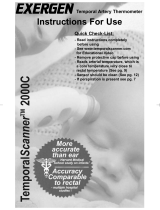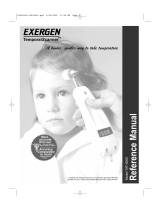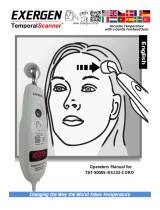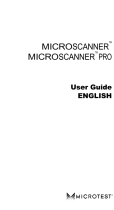Page is loading ...

EXERGEN
400 Pleasant Street - Watertown, MA 02472
Phone: 617.923.9900 Fax: 617.923.9911
www.exergen.com
e-mail: [email protected]
DX SERIES
Handheld Infrared
Thermometers
User’s Guide


Table of Contents
Chapter One - Welcome to Infrared Thermometry . . . .1
1.1 Introduction . . . . . . . . . . . . . . . . . . . . . . . . . . .1
1.2 Product Features . . . . . . . . . . . . . . . . . . . . . . .1
1.3 Models and Ordering Information . . . . . . . . . . . . . . .1
Chapter Two - Operation . . . . . . . . . . . . . . . . . . . . . . .2
2.1 DX Controls . . . . . . . . . . . . . . . . . . . . . . . . . . .2
2.2 To Change Display Measurement Units . . . . . .2
2.3 To Change Mode of Operation . . . . . . . . . . . . .3
2.4 Temperature Measurements . . . . . . . . . . . . . . .3
2.4.1 General Operation . . . . . . . . . . . . . . . . .3
2.4.2 Temperature Measurement of
Moving Targets . . . . . . . . . . . . . . . . . .3
2.4.3 High Temperature Targets . . . . . . . . . . .5
2.5 MAX Mode Temperature Measurements . . . . . .5
2.5.1 General Operation . . . . . . . . . . . . . . . . .5
2.6 SCAN Mode Temperature Measurements . . . . .6
2.6.1 General Operation . . . . . . . . . . . . . . . . .6
Chapter Three - Measurement Tips . . . . . . . . . . . . . . . .6
3.1 Optimizing Target Area Measurements . . . . . . .6
3.2 Measuring Metallic Targets . . . . . . . . . . . . . . . .6
3.3 Optimizing AESC Measurements for
NIST Traceability . . . . . . . . . . . . . . . . . . . . . . .7
3.4 Measuring Transparent Materials . . . . . . . . . . .7
3.5 Measuring Wet or Icy Surfaces . . . . . . . . . . . . .8
Chapter Four - Maintentance . . . . . . . . . . . . . . . . . . . . .8
4.1 Battery Replacement . . . . . . . . . . . . . . . . . . . .8
4.2 Cleaning . . . . . . . . . . . . . . . . . . . . . . . . . . . . . .8
4.3 Storage . . . . . . . . . . . . . . . . . . . . . . . . . . . . . .8
4.4 Calibration . . . . . . . . . . . . . . . . . . . . . . . . . . . .9
Chapter Five - Troubleshooting . . . . . . . . . . . . . . . . . . .9
5.1 Diagnostic Codes . . . . . . . . . . . . . . . . . . . . . . .9
5.2 Troubleshooting Measurement Difficulties . . . . .11
Chapter Six - DX™ Specifications . . . . . . . . . . . . . . . . .11
Chapter Seven - Warranty . . . . . . . . . . . . . . . . . . . . . . .12

Chapter One - Welcome to Infrared
Thermometry
1.1 Introduction
Exergen Corporation, the world's leading manufacturer of infrared
temperature systems, presents the low cost DX Series™ of hand held
infrared thermometers. These dual-purpose systems function as both
NIST traceable temperature calibrators and thermal scanning devices.
Make fast, accurate, and reliable temperature measurements using
advanced non-contact IR technology.
Meet your company's product quality conformance needs with the
DX's patented Automatic Emissivity Compensation System (AECS).
In this mode, the unit will provide precision temperature measure-
ments of spot targets, without knowing the target's emissivity value,
and without errors caused by other sources of incident radiation.
Since the DX is NIST traceable, it can function as a primary tempera-
ture calibrator for other temperature measuring devices, serving your
corporate quality instrument calibration programs. Operate the DX in
SCAN mode, for thermal scanning measurements over a range of tar-
get temperatures. Thermal Scanning is very useful in many applica-
tions such as evaluating insulation, monitoring machinery, and
inspecting electrical equipment. Or the DX may be operated in the
MAX mode where the highest temperature measured while monitoring
is presented.
This manual provides complete instructions on how to operate and
use your DX--to provide fast, accurate, reliable temperature measure-
ments for your application needs.
1.2 Product Features
Designed for ease of use and measurement flexibility, the DX fea-
tures:
• Dual purpose, AECS as well as MAX and SCAN measurement
modes
• Measurement resolution to 0.1 °F or 0.1°C
• Factory calibration for precise results
• A 10 second display reading hold
• Internal self test and error diagnostic codes to insure proper
function
1.3 Models and Ordering Information
DX 501 -50 to 550°F (-45 to 287°C) Unit includes a 9 V DC Alkaline
Battery and DX Instruction Manual. Also available with a
Remote Sensor, and RS232 Digital Output.
1

DX 1001 0 to 1000°F (-18 to 538°C) Unit includes a 9 V DC Alkaline
Battery and DX Instruction Manual. Also available with a
Remote Sensor, and RS232 Digital Output.
DX 1201 0 to 1207°F (86 to 653°C) Unit includes a Remote Sensor,
9 V DC Alkaline Battery and DX Instruction Manual.
DX 1601 0 to 1600°F (86 to 871°C) Unit includes a Remote Sensor,
9 V DC Alkaline Battery and DX Instruction Manual.
Chapter Two - Operation
2.1 DX Controls
LED Display
MEASUREMENT
button
LED Display
Sensor Window
AECS Cup
Battery Cover
Screw
Displays target temperature and diag-
nostic codes
Measurement
button
To turn on and perform temperature
measurements
Nosepiece
w/AECS cup
Sensor window
Automatic Emissitivity Compensation
System (AECS) nosepiece to contact target
Sensor viewing area for IR detector
2

2.2 To Change Display Measurement Units
The DX Models come from the factory displaying temperature in units
of Fahrenheit. To display readings in units of Celsius, perform the fol-
lowing steps:
1. Remove the screw from the underside of the case.
2. Remove the cover, exposing the battery area.
3. Locate the push button switch as shown in the picture.
4. With the unit off (display is blank), push the push button in.
5. Holding the push button in, turn the unit on with the MEASURE-
MENT button.
The instrument now reads in °C instead of °F. To return to the original
setting, simply repeat the process.
2.3 To Change Mode of Operation
The DX Models come from the factory operating in the MAX mode.
To change to the SCAN mode perform the following steps:
1. Remove the screw from the underside of the case.
2. Remove the cover, exposing the battery area.
3. Locate the slide switch as shown in the picture.
4. Change the position of the slide switch from 1 to ON.
The unit will now operate in the SCAN mode. ON Î SCAN,
1 Î MAX.
ºF/ºC Switch
MAX/SCAN Switch
3

2.4 Temperature Measurements
2.4.1 General Operation
CAUTION... SHOCK HAZARD
DO NOT TOUCH THE INSTRUMENT TO
ELECTRICAL CONDUCTORS*
The DX™ measures temperature very quickly. To obtain an accurate
measurement, it is only necessary to touch the surface for a fraction
of a second.
For exact surface temperature measurements that are NIST traceable,
use the following procedure:
1. Press and hold the MEASURE button.
2. The display will briefly show [8888].
3. Touch the nosepiece to the target surface.
4. The display may or may not change, but the "beeping" sound will
indicate that measurements are being made.
5. Record the temperature from the display.
6. Release the MEASURE button. The last reading will remain
locked on the display for 10 seconds after releasing the button.
*If the target is electrical equipment, Exergen manufactures the Model
E Microscanner instruments for safe and convenient inspection of
electrical equipment. Contact Exergen for more information on the
Model E line of instruments and electrical inspection. If the surface
is metallic, be sure to mark it as described in the Measurement Tips
section in Chapter Three.
2.4.2 Temperature Measurement of Moving Targets
To measure moving targets that are not possible to touch, use the fol-
lowing procedure:
1. Press and hold the MEASURE button.
2. The display will briefly show [8888].
3. Bring the nosepiece as close as possible to the target, preferably
within 1/32 inch (1 mm). **
4. The display may or may not change, but the "beeping" sound will
indicate that measurements are being made.
5. Record the temperature from the display.
6. Release the MEASURE button. The last reading will remain
locked on the display for 10 seconds after releasing the button.
4

** If the surface is metallic, be sure to mark it as described in the
Measurement Tips section in Chapter Three.
2.4.3 High Temperature Targets
When using the DX™ to measure high temperature targets, above
100 °F, quickly touch the target's surface -- one second is long
enough to get an accurate reading.
Follow the procedures described above under 2.4.1 General
Operation (see pg. 5). If the DX makes contact with a hot surface for
an extended time (10 seconds or more) the target will conduct heat.
Although this will not harm the unit, the indicated temperature may be
a few degrees too high. Allow a few minutes between readings for
the nosepiece to cool down and stabilize.
If the DX makes contact with a hot surface and an error message [HI]
shows on the display remove the instrument from the object immediately.
2.5 MAX Mode Temperature Measurements
Use this measurement mode when making contact with the target or
when the target is large. The DX is a wide-angle thermal scanner
with a fixed emissivity of 0.9. The target's temperature is continuous-
ly displayed and updated 10 times per second for as long as you hold
the MEASURE button down.
The DX displays the average temperature of everything within the
sensor's field of view measurement area. The size of the measuring
area depends on the distance of the device from the target. The DX
has a 1:1 field of view, which means that this unit will measure a 1"
diameter target area when the device is 1" from the target.
2.5.1 General Operation
For continuous temperature measurement of a target or for tempera-
ture measurement at a distance, use the following procedure.
1. Determine the appropriate measurement distance from your
desired target. Best measurements are made when the AECS
cup is in contact with the target.
2. Make sure the MODE switch is on MAX.
3. Point the nosepiece at the target.
4. Press and hold the MEASURE button.
5. Record the temperature from the display.
6. Release the MEASURE button. The last reading will remain
locked on the display for 10 seconds after releasing the button.
5

2.6 SCAN Mode Temperature Measurements
Use this measurement mode for thermal scanning of a target or when
measuring targets located at a distance. The DX is a wide-angle ther-
mal scanner with a fixed emissivity of 0.9. The target's temperature is
continuously displayed and updated 10 times per second for as long
as you hold the MEASURE button down.
The DX displays the average temperature of everything within the
sensor's field of view measurement area. The size of the measuring
area depends on the distance of the device from the target. The DX
has a 1:1 field of view, which means that this unit will measure a 1"
diameter target area when the device is 1" from the target.
2.6.1 General Operation
For continuous temperature measurement of a target or for tempera-
ture measurement at a distance, use the following procedure.
1. Determine the appropriate measurement distance from your
desired target.
2. Make sure the MODE switch is on SCAN.
3. Point the nosepiece at the target.
4. Press and hold the MEASURE button.
5. Record the temperature from the display.
6. Release the MEASURE button. The last reading will remain
locked on the display for 10 seconds after releasing the button.
Chapter Three - Measurement Tips
3.1 Optimizing Target Area Measurements
When performing a continuous thermal scan of a target, or measuring
a target located at a distance, proper target alignment will help assure
accurate results. Since the DX's sensor measurement area is fixed at
a field of view of 1 to 1, it is important to properly determine the best
measuring distance from the target, to optimize the reading. A field of
view of 1 to 1 means that the DX’s viewing area is 1" diameter for 1"
distance from target. Optimize optical alignment, so that the DX
views only the target and does not exceed the measurement area.
6

See Figure below for examples of proper optical alignment.
3.2 Measuring Metallic Targets
In general, infrared thermometers can easily measure non-metallic
surfaces because they emit most of their potential heat. Metallic sur-
faces, on the other hand, are poor emitters and require special treat-
ment before infrared thermometers can accurately measure their tem-
perature. Fortunately, that special treatment is simple and can be
easily accomplished by marking the metallic surface you wish to
measure with a non-metallic substance such as a solid paint marker.
Other substances such as grease, oil, or tape may also be used. It is
only necessary to mark an area slightly larger that the DX nosepiece,
when operating in AECS mode. When operating in MAX or SCAN
modes, mark the appropriate target area for the measuring distance
from the target, based on a 1 to 1 Field of View.
3.3 Optimizing AESC Measurements for NIST
Traceablity
If you look at the DX's nosepiece, you will see that it is really a small
reflective cup with the sensor's window at its base. When the DX's
nosepiece touches the surface of an object, that reflective cup auto-
matically controls what the sensor sees by eliminating variables such
as target emissivity and extraneous radiation. Patented by Exergen
as the Automatic Emissivity Compensation System (AECS), this
unique design ensures accurate readings every time. To optimize
results, make sure that the nosepiece is flush with the target when
possible, so that the reflective cone can completely trap out any light
or incident radiation from the environment.
3.4 Measuring Transparent Materials
Although transparent materials pass visible light, many visibly trans-
parent materials are opaque in the infrared and can be directly meas-
ured by the DX.
To test for infrared transparency, touch the DX to the target's surface
and pass a heat source such as your hand or a penlight through the
sensor's field of view on the other side of the material.
7
POOR POOR GOOD

If the DX responds to the heat source, the material is transparent in
the infrared, and requires marking the surface for proper measure-
ment. Mark the surface with an opaque non-metallic coating, such as
paint or grease.
Alternatively, place a shiny metallic object, such as aluminum foil,
behind the transparent material. The shiny metal will reflect the tar-
get's heat back to the DX.
3.5 Measuring Wet or Icy Surfaces
Wet or icy surfaces may interfere with the DX's readings. Water and
other liquids are good targets, but evaporation lowers their surface
temperatures.
Frost forms on a surface at the freezing point of water. Frozen foods
or similar targets will form frost unless the environment is controlled.
If frost forms, the DX will measure the temperature of the frost instead
of the object's temperature.
Melting ice will read slightly higher than 32 °F (0°C) because the
instrument actually measures the air condensing on the ice, a reac-
tion that generates a small amount of heat. As long as the ice is not
melting, the DX will accurately read its temperature.
To make an accurate target measurement, remove any ice or mois-
ture before measuring.
Chapter Four - Maintenance
The high-performance DX is a rugged and durable instrument,
designed for long term performance reliability.
4.1 Battery Replacement
Open the instrument's cover to access the battery by loosening the
screw on the back of the instrument. Remove the old battery and
replace it with one fresh, 9 V alkaline battery. Align the battery con-
tacts as indicated on the case.
4.2 Cleaning
The only maintenance required involves keeping the sensor window
clean. This window, located at the base of the nosepiece's reflective
cup, is made of a special crystal that passes infrared heat. Dirt,
greasy films, or moisture on the window will interfere with the passage
of infrared heat and affect the accuracy of the instrument.
8

If necessary, clean the sensor window and reflective cup with a cotton
swab dipped in alcohol. Periodic cleaning is a good practice.
4.3 Storage
When not in use, store the DX such as to protect the unit from dirt and
dust. Do not store the unit in areas of extreme heat, cold, or humidity.
If not using the DX for a long period, remove the battery from the unit.
4.4 Calibration
The DX is factory calibrated under high quality standards. Because
there are no mechanical adjustments, the instrument is able to main-
tain its calibration through vibration and normal use. No field calibra-
tion is necessary.
Chapter Five - Troubleshooting
5.1 Diagnostic Codes
The high-performance DX™ continuously monitors its ability to pro-
duce accurate temperature readings. If either the target's tempera-
ture or the unit's ambient temperature exceeds the operational limits,
the display will default to an error message.
The battery voltage is also monitored. A low battery is indicated by a
separate error code. The unit will continue to operate as long as
accuracy can be assured. If the battery drops below 5.7 volts, the
battery is considered "dead" and the display defaults to [----].
If the [E-##] or [Err] error messages are displayed, the unit will not
function and must be returned to the factory for repair. (See section
on Warranty for return instruction).
The following charts summarize the fault condition, and the associat-
ed indication.
9
Model DX 501 [HI] Target >550°F
(287 °C)
Use higher
DX
Model DX 1001 [HI] Target >1000
°F (538 °C)
Use higher
DX
Model DX 1201 [HI] Target >1207
°F (653 °C)
Use higher
DX
Model DX 1601 [HI] Target >1600
°F (871 °C)
Contact
Exergen
High Target Temperature
Condition Error
Code
RemedyMeasurement
Fault

10
Model DX 501 [LO] Target < -50 °F
(-45 °C)
Contact
Exergen
Model DX 1001 [LO] Target <0 °F (-
18 °C)
Use lower DX
Model DX 1201 [LO] Target <186 °F
(86 °C)
Use lower DX
Model DX 1601 [LO] Target <186 °F
(86 °C)
Use DX 501
or DX 1001
Low Target Temperature
Condition Error
Code
RemedyMeasurement
Fault
High Ambient
Temperature
[HI A] Ambient > 122
°F (50 °C)
Move to
alternate
location
Low Ambient
Temperature
[LO A] Ambient < 32
°F (0 °C)
Move to
alternate
location
Low Battery [N/A] Battery power
low
Replace
battery
Dead Battery [----] Dead battery Replace
battery
Other Errors
Condition Error
Code
RemedyMeasurement
Fault
Processing
Error
[E-##]
or [Err}
Internal fault
Repeat
measurement,
if error
remains,
contact
Exergen

5.2 5.2 Troubleshooting Measurement Difficulties
If you experience measurement problems, review the following
troubleshooting steps:
Is the sensor window clean?
Clean the sensor window and reflective cup and repeat the measurement.
Is the target's surface non-metallic?
Coat metallic surfaces with a non-metallic finish and repeat the measurement.
Is the target's surface transparent?
Coat transparent surfaces with an opaque non-metallic finish and
repeat the measurement.
Alternatively, put a shiny metallic surface such as aluminum foil
behind the transparent target and repeat the measurement.
Was the instrument's nosepiece in contact with the surface?
Touch the nosepiece flush to the target's surface and repeat the
measurement.
If after applying all of the above solutions, the instrument's accuracy
is still in question, contact Exergen for further help.
Chapter Six - DX™ Specifications
Target Temperature Range
DX 501 -50 to 550°F (-45 to 287°C)
DX 1001 0 to 1000°C (-18 to 538°C)
DX 1201 186 to 1207°F (86 to 653°C)
DX 1601 186 to 1600°F (86 to 871°C)
Linearity Error
DX 501 ± 1% of reading
DX 1001 ±3% of reading
DX 1201 ±3% of reading
DX 1601 ±3% of reading
Emissivity Error
±1% of max. difference between target temperature and instrument
temperature when touching, for emissivity of 0.8 to 1.0
Minimum spot size diameter
Approx. 1/4" (6.4 mm)
Repeatability
± 0.1 °F/°C
NIST Traceablity
In AECS Mode
11

Display Resolution
0.1 °F or 0.1 °C
Display Update
10 times/second
Measurement Response Time
Approximately 0.1 seconds
Field of View
1:1 0.63" (15.9 mm) Diameter Spot Area in AECS Mode
Spectral Sensitivity
2 to 20 microns
Battery
One 9 volt
Battery Life
5000 readings (10 seconds each)
Instrument Ambient Temperature
Operating Range: 32 to 122°F (0 to 50°C)
Storage Range: -22 to 140°F (-30 to 60°C)*
*Extended storage at temperature extremes will reduce battery life.
Chapter Seven - Warranty
Exergen warrants the DX to be free of defects in material and workman-
ship for a period of one year from the date of purchase, and will repair or
replace the returned instrument at no charge during the period. No
other warranties are implied.
If repair is required:
Contact the factory for a Return Material Authorization (RMA)
Number. Mark the RMA number on both the shipping box and the
packing slip. Include a description of the unit's problem. Ship the
instrument prepaid. Exergen will return ship prepaid. After you have
received an RMA Number, send to:
EXERGEN CORPORATION
Repair Department
RMA ________________
400 Pleasant
Street
Watertown, MA 02472
12

EXERGEN
CORPORATION
400 Pleasant Street
Watertown, MA 02472
617.923.9900
FAX: 617.923.9911
818526 Rev. 3
/






